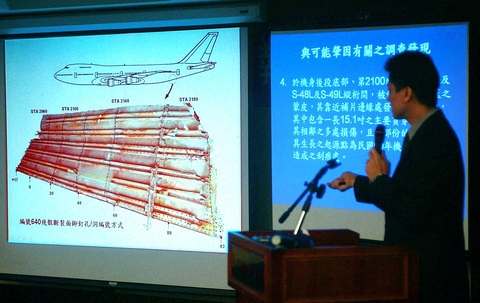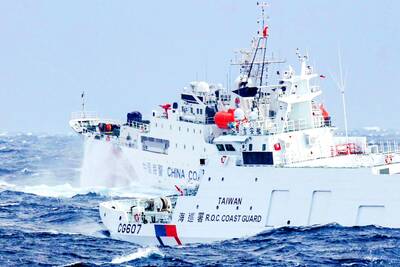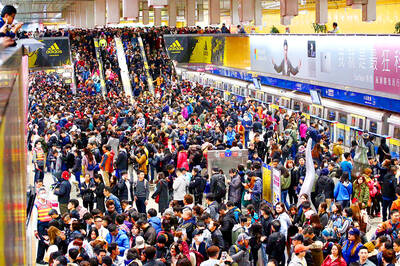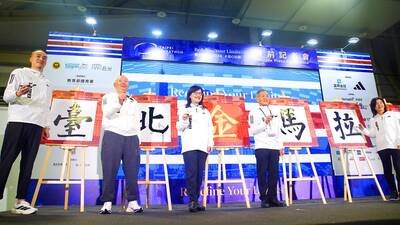The Aviation Safety Counsel (ASC) yesterday published its findings in a report on the China Airlines plane that broke into pieces over the sea between Taiwan and Hong Kong in May 2002. The report blamed cracks in the plane's fuselage, as well as poor maintenance as the cause of the crash that killed all 225 passengers on board.
On May 25, 2002, the CAL flight CI-611, a Boeing 747-200 jumbo jet, broke apart and plunged into the Taiwan Strait 23 nautical miles northeast of Penghu County shortly after takeoff from CKS International Airport.

PHOTO: CNA
After more than two years of analyzing information gathered from the plane's flight data recorder, air traffic control, wreckage distribution and a reconstructed section of the fuselage, the ASC concluded that a 180.34cm crack on the fuselage resulted in the in-flight breakup at the altitude of 10,668m, killing 206 passengers and 19 crew members.
According to the ASC, the fatigue crack in the aircraft could be dated back to an accident that took place 25 years ago. On Feb. 7, 1980, the aircraft suffered damage when its tail touched the ground while landing in Hong Kong. Although the damaged plane was shipped back to Taiwan and underwent temporary repairs the day after the incident, permanent repairs conducted by the nation's largest carrier, China Airlines, were flawed.
"China Airlines did not repair the [damage] in accordance with Boeing's [structural repair manual]. The damaged skin should have been either trimmed or removed as the standard procedure required. But the repairs did not extend sufficiently beyond the damaged area and thus, did not restore structural strength," said ASC Chairman Kay Yong (
The ASC believes that the pre-existing fissures on scratched surface, and after not having been properly fixed, deepened and grew to a 180.34cm crack as a result of pressurization and de-pressurization during flights.
"A crack measuring 180.34cm in length is long enough to cause structural separation in the fuselage. It is the root cause of the in-flight breakup of the aircraft," said Thomas Wang (王興中) head of the ASC's investigation team.
Although the ASC could not confirm exactly when the fuselage came apart, the Cabinet-level aviation authority criticized the air carrier for not finding the damage to the aging aircraft in regular checkups over the past 25 years.
CAL officials, however, rebuked the ASC's report and questioned its findings.
"Since the section of the aircraft that is suspected of causing the crash was not found, the information is not conclusive enough to determine the exact cause of the accident," CAL said in a statement.
"The ASC said that they have found 75 percent of the aircraft, but they actually collected only 50 percent of the damaged section 46, the key part needed to determine the cause of the crash," said CAL spokesman Roger Hen (
While openly disputing the ASC's findings, the air carrier objected to the claim that maintenance oversight was also to blame.
"Our checkups are conducted in compliance with the SRM [structural repair manual]. Boeing stated clearly that if repairs are done in accordance with the SRM, there is no need to report it to the aircraft manufacturer," Hen said.
According to the regulations of Boeing's Repair Assessment Program, aircraft should have undergone inspections upon reaching of 22,000 flights. Yet the accident occurred when the jet completed its 21,398th flight, a few times of landing and take-off away from the maintenance program's maximum threshold.
Civil Aeronautics Administration (CAA) slammed that the ASC's report, accusing the agency of failing to find the actual cause of the crash.
"How could the ASC jump hastily its conclusions when half of the [section in question] has yet to be found?" said CAA director-general Billy Chang (張國政).

READY: The CGA said it closely monitored China’s maritime exercise, deployed vessels to shadow the Chinese ships one-on-one and set up emergency response centers Chinese navy and coast guard ships have returned to China, signaling the end of a massive maritime exercise, authorities said yesterday. The Coast Guard Administration (CGA) released images it said showed Chinese vessels sailing north in rough seas past Taiwan on Thursday, on their way to China. “All the Chinese coast guard went back to China yesterday, so although they have not officially made any announcement, we consider it over,” CGA Deputy Director-General Hsieh Ching-chin (謝慶欽) said. Beijing has not confirmed the drills and the Chinese Ministry of National Defense did not say whether the maneuvers had taken place when asked at a

People can take the Taipei MRT free of charge if they access it at Nanjing Sanmin Station or Taipei Arena Station on the Green Line between 12am and 6am on Jan. 1, the Taipei Department of Transportation said on Friday, outlining its plans to ease crowding during New Year’s events in the capital. More than 200,000 people are expected to attend New Year’s Eve events in Taipei, with singer A-mei (張惠妹) performing at the Taipei Dome and the city government’s New Year’s Eve party at Taipei City Hall Plaza, the department said. As people have tended to use the MRT’s Blue or

PUBLIC TRANSPORT: As some roads would be fully or partially closed, people are advised to take the MRT, with services expanded to accommodate more riders This year’s Taipei Marathon, which has obtained its first gold label certification from World Athletics, is to be held from 5am to 1pm tomorrow and would have 28,000 participants. The race is to start from the Taipei City Plaza and would go through major roads throughout the city, with traffic control implemented from 6am to 2pm, officials said. The Taipei Mass Rapid Transit (MRT) system and New Taipei City MRT Circle line would start operating at 5am on the day of the race, they said. The race would cover Renai Road, Xinyi Road, Hangzhou S Road, Aiguo east and west roads,

Taipei is participating in Osaka’s Festival of Lights this year, with a 3m-tall bubble tea light installation symbolizing Taiwan’s bubble tea culture. The installation is designed as a bubble tea cup and features illustrations of Taipei’s iconic landmarks, such as Taipei 101, the Red House and North Gate, as well as soup dumplings and the matchmaking deity the Old Man Under the Moon (月下老人), affectionately known as Yue Lao (月老). Taipei and Osaka have collaborated closely on tourism and culture since Taipei first participated in the festival in 2018, the Taipei City Department of Information and Tourism said. In February, Osaka represented